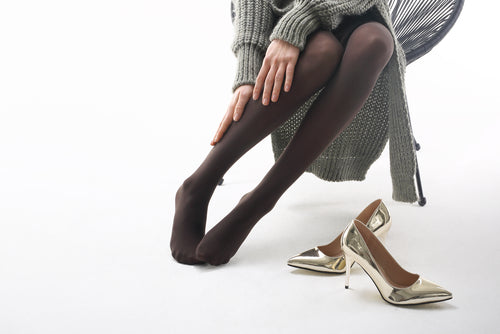The Best Compression Socks and Hosiery for Cooler Weather
If you’ve applied an ice pack to a swollen injury, you intuitively understand that cold affects your circulation. Your body responds to the cold by constricting your blood vessels, drawing blood away from the skin and back to your all-important core. This response is really helpful when you’re trying to reduce swelling, but it’s not so great during the winter months when you have no control over the cold weather.
Thankfully, there are some practical steps you can take to remedy the situation if you notice your circulation slowing during the winter, starting with compression socks. Below, we offer tips for choosing the most appropriate compression wear for winter and then suggest more ways to boost your circulation as temperatures start to drop.

Compression Socks for the Cold
Many people turn to shorter compression socks and open-toe designs during the hot summer months, but those don’t provide enough coverage during the winter. If you’re looking to buy some compression garments for the cold weather, here are four designs to consider.
Knee-High Stockings
If you want a compression sock-like design, but are looking for a little more coverage, consider knee-high compression stockings instead. These stockings come in both opaque and sheer materials, as well as four different foot options: closed toe, open toe, inspection toe and footless (you’ll probably want closed toe for the winter).
Thigh-High Stockings
If you need compression for your thighs as well as your calves, consider purchasing thigh-high compression stockings instead. Some stocking styles are held up with silicone grips on the inside of the top seam and work well under both pants and skirts. Plus, you don’t have to roll them down whenever you use the restroom. Like knee-highs, thigh-highs come in several different materials and foot styles.

Compression Pantyhose
For the fullest coverage, look to compression pantyhose, which combine the look of regular tights with the benefits of compression. Pantyhose are the right choice if you want compression for the lower half of your waist as well as the full length of your legs. If you’re expecting, maternity pantyhose will accommodate your growing belly.
Compression Sleeves
If you need compression for your arms instead of (or in addition to) your legs, browse compression sleeve options. These thin sleeves lay seamlessly under thicker winter clothes and come in neutral colors to blend into your wardrobe. If you’d rather have your sleeves stand out, look to collections such as Juzo’s compression sleeves, which come in bright prints and patterns.
More Cold Weather Circulation Tips
There are plenty of ways besides compression socks to improve your circulation during the winter. Try one of the following four tips to boost your blood flow:

Stay warm.
Keeping your body temperature up will help prevent your blood vessels from constricting. Dress warmly and always bring a jacket with you. Cuddle up under a blanket at home and use one at your office too if it’s appropriate. If you need, turn up the heat or run a small space heater, but stay cognizant of how this will affect your electricity bill and the environment.
Drink enough water.
When you become dehydrated, your body draws fluid out of the blood, making it more viscous (i.e., thicker) and causing it to flow more slowly. Staying hydrated helps promote circulation, not to mention a bunch of other vital processes. Drinking hot beverages such as decaf tea will not only keep you hydrated, it will also elevate your core body temperature and help keep you warm in the process.
Get moving.
Exercise stimulates blood flow through two mechanisms: First of all, physical activities cause your heart to beat faster, hastening blood flow. Second, the movement of the muscles pushes on the blood vessels, further increasing circulation. While many popular outdoor exercises, such as running, aren’t as pleasant during the winter, you can still join a gym or seek indoor workout classes to keep your circulation up.
Use proper posture.
It’s tempting to curl up all winter long, but don’t cross your legs when you sit or stand, as this can impede blood flow. Instead, keep your legs parallel to each other, with your feet planted firmly on the floor. Get up once an hour to walk around for a couple of minutes to get your blood flowing again.
Stay warm out there this winter, and don’t let the cold weather get your circulation down!
Kaki Zell - Vice President of Sales, Marketing, eCommerce at Legs-4-Life LLC Kaki holds a Bachelor of Science degree in Business Administration and Management from Virginia Polytechnic Institute and State University. She’s been working in the medical device industry for over 11 years and currently serves on the Board of Directors for the Greensboro Science Center.
Written May 2019 | Page last updated May 2022
Sources:
Experience Life by Life Time. “How Exercise Affects Circulation (and Vice Versa)” https://experiencelife.lifetime.life/article/how-exercise-affects-circulation-and-vice-versa/
Medical News Today. “Cold Feet: Causes and Remedies” https://www.medicalnewstoday.com/articles/320327
Meridian Valley Lab. “Dehydration Shown to Increase Blood Viscosity” https://www.meridianvalleylab.com/dehydration-shown-to-increase-blood-viscosity/